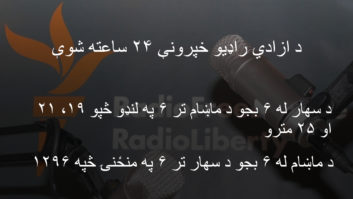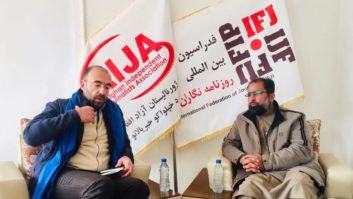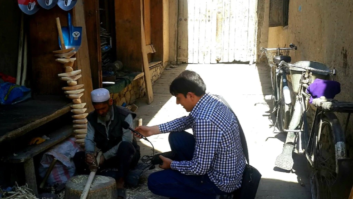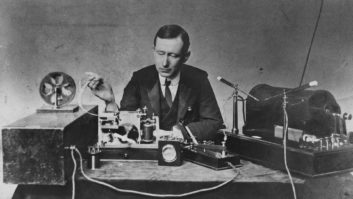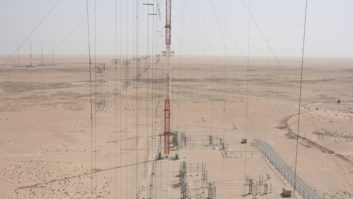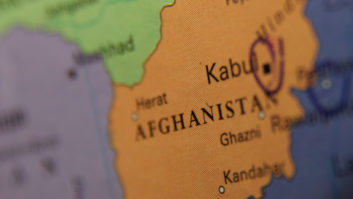Radio Afghanistan
Aug 6, 2002 12:00 PM, By Stephanie P. Snyder
Equipment ListAudionics 12 channel (split 6+6) audio control surfaces
Tascam 122 Mk3 Cassette machine
Sony CDp-D11 CD Player
Sony MDS-E12 minidisk unit
Prodys Pronto 3 ISDN unit
Audio and mains cable loom
Harbeth Monitor 20 loudspeakers
Unicol loudspeaker stands
Shure SM58 microphones
Anglepoises for microphones + mic cable
Microphone desk stand
MD-Report! PRO conversion kit for portable recorders
Sharp Portable MD Recorder
Sony MD74 Blank MiniDisc
APC UPS unitsYamaha YST speakers
Creative Labs Sound Cards
Yamaha CD-RW 2100S
Nero 5.5 Burn Proof Software for CD-RW
CoolEdit Pro
500 metres CAT 5 UTP cable
Canford Audio PCI Audio balancing card for workstations
Clyde Broadcast Products Deskmate Units with TBU
Clyde Broadcast Products Deskmate Units
Beyer DT109 Headsets
HHB Communications PA Amplifier
Folio Audio Mixer
AKG GN15 + CK31 Microphone
ATM 33A
JSS Audio VT108 Loudspeakers + mounting brackets
Tremendous obstacles face broadcasters in Afghanistan as they work to return radio and television programming to the population of the war-torn country. Once thriving, Afghanistan’s media were seriously restricted under Taliban rule. In the 90’s, the popular Radio Afghanistan was renamed Radio Voice of Shari’ah (Islamic law) and entertainment programming was banned. Broadcast facilities that were not abandoned or stripped of equipment under the Taliban were severely damaged or destroyed by US bombing.
Radio Afghanistan returned to the air in November 2001 when the Taliban left Kabul and the Northern Alliance forces took control of the station. Though programming was only offered a few hours a day, music was offered for the first time in five years. Kabul TV began a few weeks later, offering 3 hours of programming a day.
In this challenging environment, the British based, BBC World Service Trust took up the assignment of building two, new studios for Radio-Television Afghanistan. The goal: to build robust, modern, digital radio studios in a location with limited infrastructure and a staff who had not worked with computers before.
The BBC World Service has long been involved in Afghanistan, broadcasting on short wave in Persian for 60 years and in Pashtu for 20 years. Backed by the United Nations and funded by the United Kingdom’s Department for International Development (DFID), the BBC World Service Trust, a charity arm of the BBC World Service began the project to rebuild the media in Afghanistan after the ousting of the Taliban. The �1 million project included journalism courses, policy development, producer and gender training, as well as the physical refurbishment of the Radio Afghanistan studios.
As the first stage of planning, a BBC team flew to Kabul in January of 2002 to conduct a feasibility study and look at the damage. The BBC technical team was one of the first to conduct structural analysis in the region, visiting the Radio-Television Afghanistan studios, just north of Kabul as well as the Pol-e Chakri transmitter site, which fed programming to relay stations across the country.
The BBC crew found that the 50-year-old Radio Afghanistan building was structurally sound, but much of the equipment available to the broadcasters was aged. While the hardware was in working order, there were few spare parts. Many of the pieces of equipment were made by Soviet and Hungarian companies that no longer existed. In addition, the engineers at the station had been isolated for five years under the Taliban and some had not seen a computer before.
The technical staff at Radio-Television Afghanistan knew they wanted to upgrade to modern equipment. �They told us, we want something new but we have no idea what,� said World Service Trust project director, Tim Williams. The BBC World Trust hoped to introduce digital technology to the Radio Afghanistan broadcasters, but also wanted to make sure the studios were robust enough to last through heavy use and still meet the needs of the programming staff. After consultation with the engineers in Afghanistan, the BBC technical team drew up plans for two smaller, studios that would allow the broadcasters to learn and experiment, rather than one large, showcase studio. The two-studio concept would allow the Radio Afghanistan staff to handle both live and recorded programs, with one studio designated for production and preparation while the on-air hosts used the other. Studio 1, the production side, is a compact 4-meter by 3-meter room while Studio 2 is a larger 6-meters by 4�-meters. Simplicity and proven technology were key to the design plan.
Roger Francis, BBC Technology project director, managed the equipment orders and logistics for the studio installations. All of the materials were ordered in the UK. The pieces were then collated and pre-fabricated at the BBC to simplify the installation and to minimize the time that would be spent in Kabul.
Each of the two studios had the same equipment, reducing the learning curve for the operators as well as the complexity of the installation. The studios were laid out so the on-air presenter could operate the console. The custom built desks allowed two to three guests to sit at an extended table, allowing interviews to be conducted in the booth. Studio plans called for an Audionics 12-channel mixing console in each room. These were split into two six-channel audio control surfaces for maximum flexibility for the operator. Built into a freestanding desk, the consoles were wired by the BBC Technology team prior to shipment to Afghanistan. All the cabling was terminated in frames in the woodwork and all inputs and outputs are accessible through a patch bay.
In addition to the 12-channel system, the studios featured digital stinger and promo playback systems. For digital production, Cool Edit Pro was installed on each of the PCs. Also standard in the studios are Tascam cassette players and Sony CD, and minidisk players. A telephone hybrid and ISDN codec were also included to allow outside broadcasts.
Once the consoles were wired and assembled, they were crated for shipping and airlifted to Kabul in April 2002. �The biggest problem was we simply didn�t know what we would find when we got there,� said Francis, continuing, �we went off to B&Qs, an English hardware supermarket, and bought boxes of tools and supplies including sleeping bags and toilet rolls.�
Transporting 2� tons out of equipment from the UK to Kabul airport was no small logistical challenge. After arrival at the war damaged Kabul airport, three miles of bad road still lay between the shipment and the Radio-Television Afghanistan building. Several hundred boxes of cargo were unloaded from the plane and placed on rickety, old trucks. Eventually, every box made it to the final destination.
Before the new equipment could be unpacked, the old equipment was stripped from the studios. Covered in thick dust from the bombings, the rooms and hallways had to be washed down before refurbishment could begin.
After a thorough cleaning, the installation team began by reconfiguring the electrical systems within the studios. The ancient wiring was tangled and difficult to follow. Each studio had about 20 amps, but power availability fluctuated wildly throughout the day. Officially rated at 220 volts, the electricity could swing from 180 to 300 volts. To contain the fluctuating power a voltage stabilizer was installed and all PCs were connected to a UPS. Additionally, the studios have a standby generator that can be started manually to keep them on the air. At first, the generator had limited value, as the STL went through the main control room before it went to the transmitter. The master control room was not on a generator system. To resolve this problem, the new studios were set up with a patch system to allow direct connection into the transmitter line in case of emergency.
The pre-wired consoles were set in place and the team made final adjustments. A peer-to-peer server LAN network was set up to connect the PCs for digital audio file sharing and playback. Existing tie lines in the building were used to connect the studio outputs to the master control and transmit lines. The telephone hybrids and ISDN codec were not connected as the building was lacking telephone service and ISDN is not yet available in Kabul.
When the studios were finished, the BBC held three days of training for the engineers and presenters. A formal handover ceremony celebrated the completion, and the state broadcasters took control of the new facility. After a few years of stability, the station expects further funding from the United Nations Trust Fund. With the experience they have gained from the BBC built studios, Radio Afghanistan hopes they will be able to use this funding to expand and upgrade their digital facilities.

Installation of the equipment took several days.


The completed studios were spotless, and unrecognizable from their original state. These photos are of Studio 1.


Studio 2.


After the studios were complete, engineers, producers and on air staff went through training on the digital systems.
All photos courtesy of BBC World Service Trust and BBC Technology






